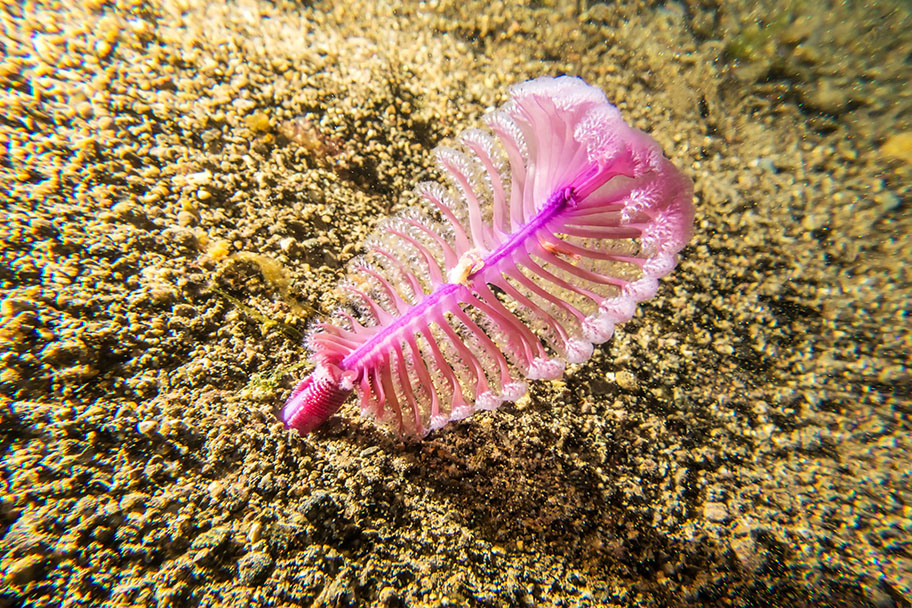How much do we know about what lives on the sea floor? Sea sponges, sea pens and deep-sea corals are just some of the mysterious creatures that live in the dark depths.
The MSC Fisheries Standard considers the impacts of fisheries on these unseen places.
The MSC Fisheries Standard considers life on the sea floor
When a fishery is assessed to the MSC Fisheries Standard, the assessment team considers how the fishery impacts the whole marine ecosystem.
A fishery cannot be certified if it causes significant damage or irreversible impact on the structure and function of a sea floor habitat. In the Fisheries Standard, we define irreversible impact as a habitat that takes 20 years or longer to recover from damage.
Fisheries being assessed under the most recent Fisheries Standard also need to consider Vulnerable Marine Ecosystems (VMEs), a term used by the UN Food and Agriculture Organisation (FAO). The FAO developed criteria defining VME habitats in 2008, defining a VME as groups of species, communities or habitats that may be vulnerable to impacts from fishing activities. The MSC applies this definition to habitats in deep and shallow water.
Our habitat requirements intend for fisheries to avoid interacting with VMEs completely. In situations where avoidance is not possible, a VME must be maintained at 80% of their unfished state.
Certified fisheries also need to work together to apply habitat avoidance measures to ensure they reduce everyone's impact on VMEs.
Fisheries taking action
The habitat requirements in the MSC Fisheries Standard encourages certified fisheries to understand and manage their impacts on the places where they fish.
In Greenland, research mapping of the sea floor has helped certified halibut fisheries understand their habitat impacts. Living on the sea floor around Greenland are corals and sponges, along with other remarkable creatures such as bryozoans, ancient lichen-like animals that form unusual colonies in the deep.
In South Africa, a certified hake trawl fishery in shallow and deep waters off the west and south coasts restricts its activities to historical trawl grounds to limit its impact on the sea floor. The fishery has supported research including a five-year experiment looking at changes to the ocean floor after areas were closed to trawling. This research found deep sea anemones and starfish living on the dark sea floor along with many more species.
This hake fishery also voluntarily observes closures within proposed Marine Protected Areas (MPA). The MPA proposals are intended to meet the Aichi 2020 targets set in the Convention on Biological Diversity, which include protection of 10% of marine areas.
In the Southwestern Atlantic, a certified scallop fishery set aside reserves in their fishing grounds to maintain breeding scallops and to keep areas free of fishing disturbance. To maintain certification, they need to study how species change in these fished and non-fished areas to make sure that fishing does not cause serious or irreversible harm to the habitat.
Using science to help fisheries manage their impacts
To help fisheries understand how they affect sea floor habitats, the MSC and Bangor University are developing a tool that will help fisheries measure their impacts in a consistent way.
The tool asks four questions:
- Where does a boat fish and how often does it fish there?
- How does the fishing gear impact the sea floor?
- What types of sea floor habitats are found within the fishery’s footprint?
- How long does each habitat type take to recover after it has been disturbed by the fishing gear used?
The tool relies on detailed information and for some fisheries this information has only just become available. For other fisheries, this information is still a long way off.
Information for the tool is collected from different places:
- Fishing vessel logbooks and vessel monitoring systems (VMS) tell us where a boat fishes and how often it fishes there.
- Research such as the Trawling Best Practice Project estimates of the impacts of fishing gear on the sea floor. This research found the depletion of habitats is strongly linked to the penetration of fishing gear.
- The species living in an ocean floor habitat tell you how long it will take for that habitat to recover after fishing. If they are long-lived species such as a coral or a sponge, the habitat will take longer to recover from disturbance.
- The sea floor itself is also important. A shallow sandbank habitat exposed to lots of tidal forces and storms will generally recover more quickly than a still, deep-sea floor muddy habitat.
Once the tool is finished, we hope it will let fisheries know how they score against the MSC Fisheries Standard habitat requirements. It will also tell fisheries how a change in fishery management can improve their scores relating to habitat impacts. The tool is likely to be introduced between 2020 and 2021.

